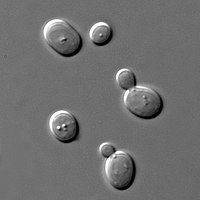
Photo from wikipedia
Abstract: The objective of this study was to determine the effects of live yeast (LY) or yeast derivatives (YD) on gas production (GP), dry matter (DM) disappearance (DMD), fermentation characteristics,… Click to show full abstract
Abstract: The objective of this study was to determine the effects of live yeast (LY) or yeast derivatives (YD) on gas production (GP), dry matter (DM) disappearance (DMD), fermentation characteristics, and microbial profiles in batch culture. The study was a completely randomized design with a factorial arrangement: 2 media pH × 5 yeasts × 4 dosages. An additional treatment of monensin (Mon) was added as a positive control for each pH level. Media pH was low (5.8) and high (6.5); the yeasts were three LY (LY1-3) and two YD (YD4-5); and doses were 0, 4 × 106, 8 × 106, and 1.6 × 107 cfu mL-1 for LY and 0, 15, 30, and 60 mg bottle-1 for YD. Substrate consisted of 10% silage and 90% concentrate (DM basis) and samples were incubated for 24 h. Media pH of 6.5 vs. 5.8, increased (P < 0.01) GP, DMD, and volatile fatty acid (VFA) concentrations but decreased (P < 0.01) NH3-N concentration and copy numbers of Ruminococcus albus, Ruminococcus flavefaciens, and Selenomonas ruminantium. Increasing dose of LY2 linearly (P < 0.05) increased DMD. Total VFA concentration was greater with LY2 (P < 0.01) than LY3 and YD5 at pH 6.5. Overall, adding yeast products improved (P < 0.05) DMD at pH 5.8, and increased VFA concentration compared with Mon. These results indicate that in vitro GP and DMD of a high-grain diet varied with source and dose of yeast supplementation. Some yeast products have the potential to improve fermentation of feedlot diets when supplemented at appropriate doses.
Journal Title: Canadian Journal of Animal Science
Year Published: 2018
Link to full text (if available)
Share on Social Media: Sign Up to like & get
recommendations!